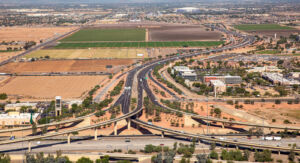The number of schools getting an F on the state’s annual report card has fallen sharply, going from 49 in 2019 to 24 this year, but the number of failing alternative schools rose over the same period.
Ranking Arizona: Top 10 charter schools for 2023
Seven alternative schools, which serve the state’s most at-risk students, got a grade of F on the state’s annual A-F School Letter Grades report, up from four in 2019.
The yearly assessment compiles students’ proficiency on standardized testing, graduation rates and other factors to derive a grade for each school. The report, released in late October, showed that five of the state’s 247 high schools got a failing grade, along with 12 of the 1,341 kindergarten through eighth grade schools in the state.
Alternative schools failed at a much higher rate, with seven of the 121 alternative schools getting an F, or 5.8% of alternative schools compared to just over 1% for traditional schools. Those were the numbers as of Monday – schools have until December to appeal their grades.
Arizona Superintendent Tom Horne said there’s no one factor at fault for alternative schools that receive a failing grade.
“The schools might be doing a good job with the students that they have,” Horne said Thursday. “They just have students that are far behind.”
The unique demands faced by alternative schools are reflected in the separate criteria used to grade them, with more weight given to students’ progress to graduation than their test scores. But, even with the current system, Horne said the standard might benefit from further improvement.
“It may be that … there should be a different standard,” he said. “We should be looking at those, because it’s not fair. They (teachers) may be doing a great job with kids that they don’t bring (to) the point of proficiency, but they might improve them in a way the public schools couldn’t.”
That was echoed by Sean Ross, executive director of the Arizona State Board of Education, who said letter grades do not necessarily represent the performance of schools and their students, but serve as an indicator of schools that may need additional state assistance.
“The important thing to understand about any school accountability model is it doesn’t capture the full gamut of what happens at a school, doesn’t capture all the beauty and amazing things that are happening at a school,” Ross said. “There’s always a limit to what any … accountability model can do.”
Schools that receive a D or F rating are connected with state resources to improve their scores.
“We have improvement teams that visit all the F schools. And so we have people of the department who will do everything they can to help,” Horne said.
Ross says it speaks to students’ and teachers’ resilience that so many alternative schools performed well this year.
“The majority of alternative schools are doing phenomenal work,” said Ross, noting that “these are the students, you know, in need of the most support in the state.”
Save Our Schools Director Beth Lewis agrees that the scores do no paint a full picture of all the work being done on campuses.
“It’s not reflective of what’s happening in those schools,” Lewis said. “There are a lot of human elements there that just are not picked up by test scores.”
Arizona Department of Education spokesperson Rick Medina said in an email that the grades are an important tool to help parents decide which school they want their child to attend.
“Arizona has excellent district schools, charter schools and Empowerment Scholarship Accounts available for parents to ensure that they can find a school that best meets the needs of their child,” Medina’s email said.
But Lewis said that, even though Horne likes to point to school choice as a solution to school problems, there is “a lot of privilege baked into that.” It may not be an option for all families with children in failing schools.
“Schools, you know, receiving D and F ratings, typically they’re in very low socio-economic areas, predominantly areas where kids are really having a hard time, families are working two to three jobs,” Lewis said. “Oftentimes younger students are being raised by their older siblings.
“These are kids that would have been cast off by society had that alternative school not existed. Are they going to score, you know, really, really well on these complicated tests?” she asked. “Not necessarily, but are they getting a poor education? No, they’re getting … a safe setting where they can learn.”
Ross said that while the report card serves a purpose, it’s important to remember the people behind the numbers.
“So often, you only hear doom and gloom when it comes to schools and yet, you know, they’re a pillar of our society, you know, teachers really held up the world during the pandemic and, and we’re … super proud of our teachers and schools and kiddos and families,” he said.




